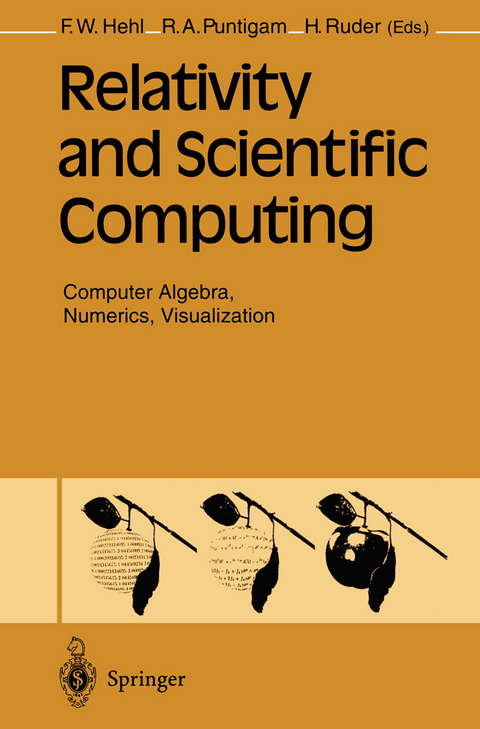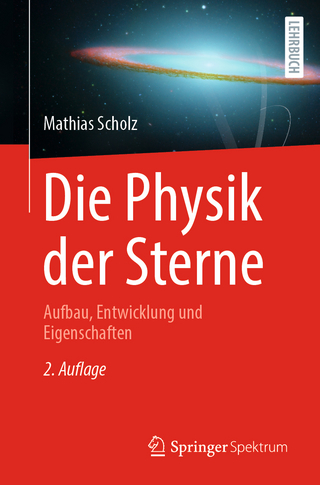
Relativity and Scientific Computing
Springer Berlin (Verlag)
978-3-540-60361-0 (ISBN)
- Keine Verlagsinformationen verfügbar
- Artikel merken
Prof. Dr. Hanns Ruder war bis zu seiner Emeritierung 1996 Professor für Theoretische Astrophysik an der Universität Tübingen. 2006 erhielt er die Medaille für Naturwissenschaftliche Publizistik von der Deutschen Physikalischen Gesellschaft.
Color Plates.- I: Numerics.- 1. Numerical Relativity and Black-Hole Collisions.- 1. Astrophysical Motivation and Mathematical Formulation for Numerical Relativity.- 1.1 Overview and Motivation.- 1.2 Mathematical Formulation of the Equations.- 2. Numerical Techniques and Supercomputing.- 2.1 Finite Difference Techniques.- 2.2 Treating Elliptic Equations.- 2.3 Treating Evolution Equations.- 2.4 Testbeds and Convergence of Numerical Solutions.- 2.5 Coding and Parallel-Computing Issues.- 2.6 General Code Strategies.- 3. Black-Hole Initial-Data Sets, Tools for Analysis, and Techniques for Evolution.- 3.1 Basic Theory and Initial-Data Sets.- 3.2 Tools for Numerical Black-Hole Spacetimes.- 3.3 Evolution.- 4. Present Research Status in Black-Hole Studies.- 4.1 Spherical BH — 1D.- 4.2 Distorted BH — 2D.- 4.3 Rotating BH — 2D.- 4.4 Colliding BH — 2D.- 4.5 Black-Hole Horizon Studies.- 4.6 3D Black-Hole Studies.- References.- 2. Four Lectures on Numerical Relativity.- 1. The Causal Structure of Einstein’s Field Equations.- 1.1 The Space-Plus-Time Decomposition.- 1.2 Invariant Algebraic Slicing.- 1.3 The Evolution System.- 1.4 Causal Structure of the Evolution System.- 2. First-Order Flux-Conservative Systems.- 2.1 Linear Systems.- 2.2 Nonlinear Systems.- 2.3 Einstein’s Evolution Equations.- 3. Standard Numerical Methods.- 3.1 Flux-Conservative Equations.- 3.2 Boundary Conditions.- 3.3 Nonsmooth Data.- 4. Total Variation Diminishing Methods.- 4.1 Flux-Conservative Methods.- 4.2 The 1D Black-Hole Test.- References.- 3. Alternatives to Finite Difference Methods in Numerical Relativity.- 1. Introduction.- 2. The 3+1 Formalism.- 3. The Initial-Data Problem.- 3.1 Multiquadrics.- 3.2 Finite Elements.- 4. Matter Evolution in Curved Spacetimes.- 4.1 Particle-Mesh Methods.- 4.2 Smoothed Particle Hydrodynamics in Curved Space.- 5. Conclusions.- References.- 4. Temporal and Spatial Foliations of Spacetimes.- 1. Introduction.- 2. Time Slicings.- 2.1 Maximal Slicing.- 2.2 Harmonic Slicing.- 2.3 Results for the Oppenheimer-Snyder Spacetime.- 3. Spatial Foliations.- 3.1 Constant Mean Curvature Foliations.- 3.2 Examples of CMC Foliations.- References.- 5. Rotating and Oscillating Neutron Stars.- 1. Introduction: Nonrotating Neutron Stars.- 2. Rotating Neutron Stars.- 2.1 Basic Formulation.- 2.2 Numerical Solution Method.- 2.3 Results.- 3. Oscillations of Neutron Stars.- 3.1 Basic Formalism.- 3.2 Results for Quasinormal Mode Frequencies.- References.- 6. Rotating Boson Stars.- 1. Introduction.- 2. Field Equations.- 3. Spherically Symmetric Boson Star.- 4. Field Equations of a Rotating Boson Star.- 5. Particle Number, Mass, and Angular Momentum.- 6. Differential Rotation.- 7. Numerical Solution.- 8. Remarks.- References.- 7. Numerical Investigation of Cosmological Singularities.- 1. Introduction.- 2. Symplectic Methods.- 3. Mixmaster Model.- 4. Gowdy Model on T3 × R.- 5. U(1) Models.- 6. Conclusions.- References.- II: Computer Algebra.- 8. Overview of Computer Algebra in Relativity.- 1. Introduction.- 2. General-Purpose Systems.- 2.1 Computer Algebra.- 2.2 Modern Systems.- 2.3 Evaluation.- 2.4 Simplification.- 2.5 Programming.- 2.6 Data Types.- 3. General Relativity Systems.- 3.1 Requirements: Riemannian Geometry.- 3.2 Requirements: GR Library.- 3.3 Requirements: Generalizations and Applications.- 3.4 Efficiency.- 3.5 Dummy Indices.- 4. Applications.- 5. Summary.- References.- 9. Two-Loop Quantum Gravity with the Computer Algebra Program FORM.- 1. Introduction.- 2. Covariant Quantization of Gravity.- 2.1 Noncovariant Method.- 2.2 Covariant Method.- 3. FORM.- 3.1 Annotated Yang-Mills Program.- 3.2 Quantum Gravity.- References.- 10. The Mathematic Packages CARTAN and MathTensor for Tensor Analysis.- 1. Mathematica.- 1.1 The Front End.- 1.2 The Kernel.- 2. Tensor Calculations.- 3. CARTAN.- 3.1 General Features.- 3.2 A Charged Black Hole.- 3.3 A Spin-Polarized Cosmic String.- 4. MathTensor.- 4.1 Tensor Indices.- 4.2 Metric Variation of R2.- 4.3 Differential Forms with MathTensor.- 5. Conclusions.- References.- 11. A Quadratic Curvature Lagrangian of Paw?owski and Raczka: A Finger Exercise with MathTensor.- 1. Introduction.- 2. Riemann Tensor and its Irreducible Pieces.- 3. The Topological Euler Density.- 4. Bach Tensor.- 5. The Bach Tensor Streamlined.- 6. Gravitational Field Equation of the P&R Model.- 7. Discussion.- References.- 12. The Program CRACK for Solving PDEs in General Relativity.- 1. Introduction.- 2. Contents of CRACK.- 2.1 General Remarks.- 2.2 Decoupling.- 2.3 Integrating Exact PDEs.- 2.4 Separation of PDEs.- 2.5 Solving Standard ODEs.- 3. The Calculation of Spacetime Symmetries.- 3.1 General Remarks.- 3.2 Generation of the Conditions.- 3.3 Post Processing of Results.- 3.4 An Example.- 4. Symmetries of a Field Theory.- 5. Applying Symmetries of Differential Equations.- 6. Future Work.- 6.1 General Remarks.- 6.2 Extending Capabilities in Dealing with DEs.- 6.3 Advanced Symmetry Investigations.- 7. Availability.- References.- 13. Algebraic Programming in the Hamiltonian Version of General Relativity.- 1. Introduction.- 2. The Local Form of the Canonical Formalism of Gravity.- 3. The Computer Procedures.- 4. About the Concrete Results.- 4.1 Spacetime Model with a Three Subspace in Form of a 3-Torus.- References.- 14. Causal Structure and Integrability in Moving Frames with Reduce.- 1. Introduction.- 2. Exterior Differential Systems.- 3. EDS Package.- 4. Ricci-Flat Immersions.- 5. Twisting Type-N Solutions.- References.- III: Visualization.- 15. Four Lectures on Computer Graphics and Dkta Visualization.- 1. Introduction.- 2. Computers, Humans, and Interaction.- 2.1 Computer Graphics Defined.- 2.2 Computer Displays.- 2.3 Graphics Hardware.- 2.4 Human Visual System.- 2.5 History of Computer Graphics.- 3. Visual Simulation.- 3.1 Visibility Calculation.- 3.2 Simulated Optics.- 3.3 Ray-Tracing.- 3.4 Rasterization.- 3.5 Graphics Pipeline.- 4. Data Visualization.- 4.1 Seeing the Invisible.- 4.2 The Analysis and Visualization Cycles.- 4.3 History of Visualization.- 4.4 Data Sources and Structure.- 4.5 Data Interpolation.- 5. Visualization Techniques.- 5.1 Scalar Fields.- 5.2 Vector Fields.- 5.3 Tensor Fields.- 5.4 Differential Geometry Applied to Height Maps.- 5.5 Second Derivatives and Curvature.- 5.6 Visualizing Higher Dimensions.- 5.7 How to Lie and Confuse with Visualization.- 6. Interactive Visualization Environments.- 6.1 Data Structures.- 6.2 Modules.- 6.3 Visual Programming Language and Execution Model.- 6.4 Programmers’ Tools.- 7. Virtual Environments in Visualization.- 7.1 Visualization over the World Wide Web.- 8. Applications and Demonstrations.- 8.1 Case Study: Structural Dynamics Using DYNA3D.- 8.2 Case Study: Helicopter Rotor Wake Visualization.- 8.3 An Example of Remote Collaboration.- 9. Conclusions.- References.- 16. Visualization in Curved Spacetimes. I. Visualization of Objects via Four-Dimensional Ray-Tracing.- 1. Introduction.- 2. Ray-Tracing Special Relativity.- 2.1 Geometrical Appearance.- 2.2 Lighting.- 3. Ray-Tracing General Relativity.- 3.1 Requirements.- 3.2 Geodesic Equation.- 3.3 Camera.- 3.4 Realizing Relativistic Ray-Tracing with Conventional Ray-Tracing Programs.- 3.5 Astrophysical Examples.- 3.6 Astrophysical Application: Light Curves of X-Ray Pulsars.- 4. Discussion.- References.- 17. Visualization in Curved Spacetimes. II. Visualization of Surfaces via Embedding.- 1. Introduction.- 2. Finding the Parametric Representation of the Embedding in R3.- 2.1 Useful Results from Differential Geometry of Surfaces.- 2.2 The System of Equations.- 2.3 An Alternative: The Darboux Equation.- 3. Examples.- 3.1 Kerr Horizon.- 3.2 Colliding Black Holes.- 4. Direct Construction of Wire Frames.- 4.1 Triangular Wire Frames.- 4.2 Surfaces with Spherical Topology.- 4.3 Procedure.- 4.4 Examples.- 4.5 Future Developments.- References.- IV: Exotica.- 18. Exotic Smoothness on Spacetime.- 1. Introduction.- 2. Differential Topology.- 3. Early Exotica of Various Kinds.- 4. Gauge Theory and Moduli Spaces.- 5. The Road to R4?.- 6. Some General Properties of R4?.- 7. Some Geometry and Physics on R4?s.- 8. Conclusions.- References.- List of Figures.- List of Tables.
| Erscheint lt. Verlag | 6.3.1996 |
|---|---|
| Zusatzinfo | XIX, 389 p. 25 illus. in color. |
| Verlagsort | Berlin |
| Sprache | englisch |
| Maße | 155 x 235 mm |
| Gewicht | 800 g |
| Themenwelt | Naturwissenschaften ► Physik / Astronomie ► Astronomie / Astrophysik |
| Naturwissenschaften ► Physik / Astronomie ► Theoretische Physik | |
| Schlagworte | astrophysics • Astrophysik • General relativity • general theory of relativity • Gravity • Hardcover, Softcover / Physik, Astronomie/Astronomie • Mathematica • Relativity • Scientific Computing • Scientific Computing / Wissenschaftliches Rechnen • Wahrscheinlichkeit |
| ISBN-10 | 3-540-60361-1 / 3540603611 |
| ISBN-13 | 978-3-540-60361-0 / 9783540603610 |
| Zustand | Neuware |
| Informationen gemäß Produktsicherheitsverordnung (GPSR) | |
| Haben Sie eine Frage zum Produkt? |
aus dem Bereich


